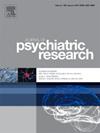c反应蛋白与双相情感障碍青少年外周血管内皮功能无关
IF 3.7
2区 医学
Q1 PSYCHIATRY
引用次数: 0
摘要
目的:尽管双相情感障碍(BD)与心血管风险之间存在明显的关联,但对该人群中血管功能障碍的病理过程的研究却很缺乏。本文研究了青年BD患者外周血管炎症与微血管功能的关系。方法纳入177例13-20岁青年(BD 93例,对照组84例)。反应性充血指数(RHI)是血管内皮功能的一种无创测量方法,采用脉冲幅度血压计进行评估。检测血清c反应蛋白(CRP)水平。我们检查了基于诊断和情绪状态的CRP差异,随后评估了总体样本中CRP和RHI之间的关系,并在控制年龄、性别和体重指数(BMI)的情况下,通过诊断CRP相互作用分析评估了CRP和RHI之间的关系。结果BD组scrp(1.94±3.99 mg/L)显著高于对照组(0.76±0.86 mg/L);U = 3044, p = 0.01),但对年龄、性别和BMI进行校正后,这一发现不成立。在整个样本中(β = - 0.07, p = 0.42),在诊断CRP相互作用分析中(β = 0.07, p = 0.73),或在控制当前抑郁(β = 0.07, p = 0.73)或躁狂(β = 0.07, p = 0.69)时,CRP与RHI无显著相关。出乎意料的是,本研究没有发现青年BD患者CRP与外周血管内皮功能之间的关系。这可能表明除了炎症之外的其他过程是BD早期血管功能障碍的基础,尤其是微血管功能障碍。本文章由计算机程序翻译,如有差异,请以英文原文为准。
C-reactive protein is not associated with peripheral endothelial function among youth with bipolar disorder
Objective
Despite robust associations between bipolar disorder (BD) and cardiovascular risk, there is a paucity of research on the pathologic processes underlying vascular dysfunction in this population. Here, we examine the relationship between peripheral inflammation and microvascular function in youth with BD.
Methods
One hundred seventy-seven youth ages 13–20 (n = 93 BD, n = 84 controls) were included. Reactive hyperemia index (RHI), a non-invasive measure of vascular endothelial function, was evaluated using pulse amplitude tonometry. Serum was assayed for C-reactive protein (CRP). We examined differences in CRP based on diagnosis and mood state, and subsequently assessed for the relationship between CRP and RHI in the overall sample and in CRP-by-diagnosis interaction analyses, controlling for age, sex, and body mass index (BMI).
Results
CRP was significantly higher in the BD group (1.94 ± 3.99 mg/L) relative to the controls (0.76 ± 0.86 mg/L; U = 3044, p = 0.01), but this finding did not survive correction for age, sex, and BMI. CRP was not significantly associated with RHI in the overall sample (β = −0.07, p = 0.42), in CRP-by-diagnosis interaction analyses (β = 0.07, p = 0.73), or when controlling for current depression (β = 0.07, p = 0.73) or mania (β = 0.07, p = 0.69).
Conclusions
Unexpectedly, this study found no relationship between CRP and peripheral endothelial function among youth with BD. This may suggest that processes other than inflammation underlie early vascular dysfunction in BD, particularly microvascular dysfunction.
求助全文
通过发布文献求助,成功后即可免费获取论文全文。
去求助
来源期刊

Journal of psychiatric research
医学-精神病学
CiteScore
7.30
自引率
2.10%
发文量
622
审稿时长
130 days
期刊介绍:
Founded in 1961 to report on the latest work in psychiatry and cognate disciplines, the Journal of Psychiatric Research is dedicated to innovative and timely studies of four important areas of research:
(1) clinical studies of all disciplines relating to psychiatric illness, as well as normal human behaviour, including biochemical, physiological, genetic, environmental, social, psychological and epidemiological factors;
(2) basic studies pertaining to psychiatry in such fields as neuropsychopharmacology, neuroendocrinology, electrophysiology, genetics, experimental psychology and epidemiology;
(3) the growing application of clinical laboratory techniques in psychiatry, including imagery and spectroscopy of the brain, molecular biology and computer sciences;
 求助内容:
求助内容: 应助结果提醒方式:
应助结果提醒方式:


